
Jordan River Delta Plain, below Bethsaida April 2008
ISRAEL PHOTOS IV -- Pilgrimage |
MUSTARD
Mark 4 (WEB)
30 He said, “How will we liken God’s Kingdom? Or with what parable will we illustrate it? 31 It’s like a grain of mustard seed, which, when it is
sown in the earth, though it is less than all the seeds that are on the earth, 32 yet when it is sown, grows up, and becomes greater than all the
herbs, and puts out great branches, so that the birds of the sky can lodge under its shadow.” 33 With many such parables he spoke the word to them,
as they were able to hear it. 34 Without a parable he didn’t speak to them; but privately to his own disciples he explained everything.
Matthew 13 (WEB)
31 He set another parable before them, saying, “The Kingdom of Heaven is like a grain of mustard seed, which a man took, and sowed in his field;
32 which indeed is smaller than all seeds. But when it is grown, it is greater than the herbs, and becomes a tree, so that the birds of the air
come and lodge in its branches.”
Here the mustard seed is described as an herb or garden plant. Its height was great and in Matthew the mustard plant was described as a tree. I found one growing above ten feet and it was not likely the tallest mustard that ever grew. A taller one was even more like a tree than a lowly herb low to the ground. The truth of the parable is that though faith might start as a small thing. Later it might produce miracles. If it will grow, then its works will be seen.

Jordan River Delta Plain, below Bethsaida April 2008
Having read a few accounts of very tall mustard plants in early books, I traveled to Israel praying that I might see the giant mustard. I have seen them flowering as early as March, yet they typically reached maximum height around Lake Tiberias (Sea of Galilee/Yam Chinnereth) in April. I have tasted both the seeds and the leaves of the plant and have verified it is a species of the mustard family, a short pod black mustard. The seed is brown/black. The pod typically contained 1-3 seeds.
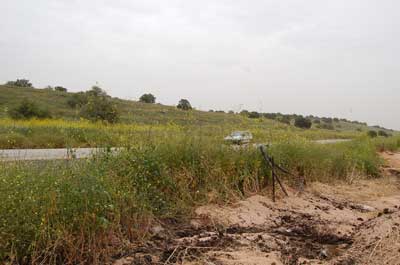
I spent vacation time roaming through Israel by car and on foot. One day I was driving in the Golan above the eastern shore of Lake Tiberias and found mustard plants in a thick group; some over eight feet tall. I knew it was thick enough to provide cover for birds from their enemies the hawks and the owls. Years later I traveled again and found the tall type of mustard in the Jordan Delta not the great height of trees, but of a shape similar to a tree with sturdy branches. The same day I found a ten foot, two inch mustard plant along the road from Bethsaida to the Golan within a few kilometers of Bethsaida.
The Talmud described use of mustard for sauce, but not too much at once as it was bitter. There was wild and domesticated mustard in those days. The Jews were not allowed to mix their fields with two types of seeds, i.e. wheat and cucumbers. They were supposed to set aside a separate plot for each crop defined by borders. The wild and domestic mustard were considered two different types of seeds. In the summer the mustard was in dry brittle seed pods and I sampled it in various places across Israel. The seeds were not uniform in flavor. This mustard plant grew along the coastal plain north of the Ben Gurion Airport region and in Galilee north from the lake, up the Jordan Valley, all the way to the Lebanese border and up to the sides of Mt. Hermon as far as the upper villages. Mustard grew very quickly; this type of mustard was not to be shaded out by other annuals. It was soon ten feet tall. Nothing stopped it. Its leaves are used for salad, its seeds were heavy with vegetable oil. The long shoots may have been used to thatch roofs in Talmudic times as they may have grown in excess of ten feet in some places. The birds of the air walked around under the mustard thicket to be hidden from hawks.
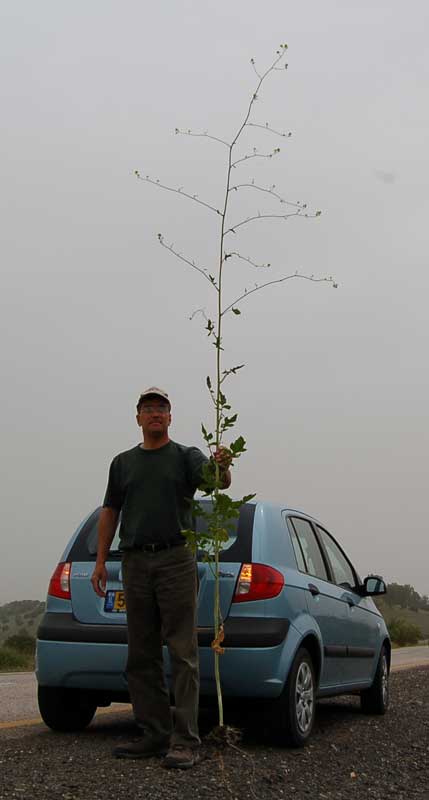
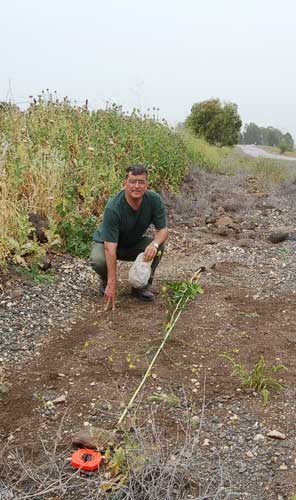
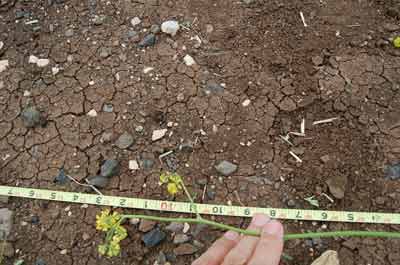
April 6, 2008 at the side of Rte. 888 above Bethsaida --
This year the mustard reached a peak height in early April near the Sea of
Galilee.
The end of the rainy season and onset of high temperatures
determined when the mustard stopped growing, died, and started to dry
out.
The Land and the Book, William Thomson, 1882, New York:
The land between the ford (Jordan River near the Zarqa/Jabbok Brook) and the bridge is so thickly overgrown with bushes as to quite conceal the ruins, and
vegetation grows rank about them, especially the wild mustard. With the help of my guide, I uprooted a veritable mustard-tree which was more than
twelve feet high In the presence of such stout bushes, which overtop all the surrounding "herbs," one feels that there was no exaggeration in the parable
about the mustard seed: "Which indeed is the least of all seeds: but when it is grown, it is the greatest among herbs, and becometh a tree, so that
the birds of the air come and lodge in the branches thereof."
A description of a place near Lake Huleh in Galilee: "The thistles are higher than our heads even on horseback, and so thorny that the horses hesitate to pass through them. Wild mustard grows equally tall; and I saw little birds, mostly finches, 'lodge in the branches thereof."
The Natural History of the Bible, H.B. Tristram, 1880, London:
The Common Mustard of Palestine is Sinapis nigra of the order Cruciferae, the Black Mustard, which is found abundantly in a wild state, and is also
cultivated in the gardens for its seed. It is the same as our own Mustard, but grows especially in the richer soils of the Jordan Valley to a much greater size than
in this country. We noticed its great height on the banks of the Jordan as have several other travelers; and Dr. Thomson remarks that in the plain of Acre
he has seen it as tall as a horse and its rider...A difficulty has been raised against any Sinapis being the mustard of the parable, because it is called;
'a tree' and 'a great tree,' in the branches of which the fowls of the air lodge. But, in the first place, we must remember that the expression is a
proverbial Oriental figure, in which literal exactitude is not to be looked for; and at the same time the Mustard is called a tree, it is expressly stated
to be a 'herb,' a 'garden herb' and in comparison with the other herbs of the garden which it so much surpasses in size, it is alone called a 'tree,'
though with respect to trees properly so termed it could not be one at all. Again, we are told that the birds of the air come and lodge in the
branches thereof. This does not mean, nor is there the slightest ground for supposing it to mean that the birds build their nest in it, but simply that
they lodge or perch there, and settle in the branches of it; as the goldfinches and linnets do in flocks, for the sake of the seed, of which they are very
fond. The Greek word merely means 'to settle' or 'rest upon' for a longer or shorter time.
The Holy Land and the Bible, Geikie, Cassel & Company, 1887:
A description of Magdala at the NW corner of the Sea of Galilee/Yam Chinnereth:
The houses, or huts of which there are not more than a dozen altogether, are built of mud and stone, and are of one story and flat roofed, with no
light except from the door; a rough pillar of mud and stone in the one room holds up the ceiling of reeds and branches, and two levels in the mud floor mark
the respective bounds of man and beast; for fowls, goats, and perhaps an ass, or some other creature, share the premises with the family. Some unspeakably
dirty, almost naked children followed us about. The ground was rank with brambles, wild mustard, coarse grass.
The Holy Land in the Light of Recent Surveys and Explorations, Edited by H. B. Waterman, 1895, Chicago (after two visits to
Palestine) RE: Mustard
"This plant (mustard) grows on the rich plain of Accho (Israel) as tall as the horse and his rider. Plants of much lower stature would afford
shelter to the birds of the air.
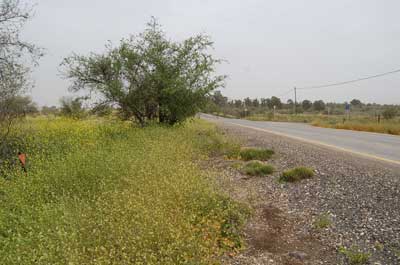
No matter how many miles one must travel, no matter how far off one has wandered, if one calls on God's name with knowledge of the teachings of Christ and repentance in mind, one might get directions.
Matthew 17 (WEB)
18 Jesus rebuked him, the demon went out of him, and the boy was cured from that hour. 19 Then the disciples came to Jesus privately, and said,
“Why weren’t we able to cast it out?” 20 He said to them, “Because of your unbelief. For most certainly I tell you, if you have faith as a grain of
mustard seed, you will tell this mountain, ‘Move from here to there,’ and it will move; and nothing will be impossible for you. 21 But this kind doesn’t
go out except by prayer and fasting.”
Cicero (106-43 BC): Faith makes good on its promises.
De Officiis, Book 1:23
"And therefore we may follow the Stoics, who diligently investigate the etymology of words; and we may accept their statement that "good faith" is so
called because that what is promised is "made good," although some may find this derivation rather far fetched."